The Boxee Box Review
by Anand Lal Shimpi & Ganesh T S on November 23, 2010 5:42 PM EST- Posted in
- Gadgets
- Media Streamer
- HTPC
- Boxee Box
Inside the Boxee Heptahedron
I suspect a cube was too boring, so D-Link lopped off a portion of the common shape and made the box rest at an angle. Calling it the Boxee Heptahedron might scare away too many potential customers so the two companies settled on the name Box.
The base is made out of a soft rubber in bright NVIDIA green (perhaps homage to the Tegra 2 that originally powered the box). The remaining sides are black plastic. The Boxee logo on the front glows bright green when the box is powered up.
Around back there’s a 10/100 ethernet port, HDMI output, optical and RCA stereo out options for audio, DC power input and two USB ports for attaching USB sticks or external hard drives. There’s an SD/MMC card reader on the side and internally you’ve got 802.11n wireless support.
The Box is small, measuring 12.7cm x 11.43cm x 8.9cm - 12.7cm (5" x 4.5" x 3.5 - 5.0" - L x W x H). It doesn’t really match any home theater gear but it’s stylish enough to not matter.

From left to right: Nikon D70, Boxee Box, Apple TV
Internally the Boxee Box is driven by an Intel CE4100 SoC and paired with 1GB of DDR3 memory.
The entire system is cooled by a single fan. The fan isn't loud but it is noticeable in an otherwise silent room thanks to its groaning sound. I couldn't hear it over any of the content I was watching however, even during quiet moments.
The Boxee Box is pretty easy to take apart, you just need a long Phillips head screwdriver with a small bit. Peel off the bright green rubber on the bottom to reveal the first six screws you'll need to remove.
Once inside there are a dozen or so other screws you'll need to remove to gain access to the motherboard (the gallery above shows you most of the process). The power supply is external which keeps a lot of clutter out of the case itself. The heatsink uses a thermal pad to make contact with the SoC making removing/replacing it a breeze:
The motherboard itself is tiny, much smaller than a mini-ITX board. I'm sure a lot of folks would be very pleased if Intel or someone else made a reference design like this that you could just buy on your own:
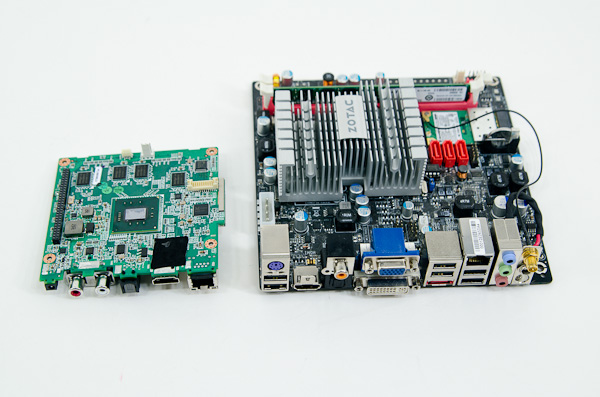
Boxee Box CE4100 motherboard (left) vs. Zotac ION mini-ITX motherboard (right)
See that little black tape covering a piece of the Boxee motherboard? Lift it up and you'll see a pretty significant rework on the board:
See the resistor mated over R12 (about half an inch from the top of the board in the above picture)? That's a rework. An error in the original PCB layout that had to be corrected after the fact. There's actually another one about half an inch lower. These two reworks appear to be on all Boxee motherboards. The black tape is used to keep them from being knocked loose. Future revs of the board will likely correct this problem and avoid the rework entirely. It's not a problem at all and won't impact reliability, just interesting to see on a final retail product.
The CE4100 die measures approximately 8mm x 12mm, putting its total die area at 96mm2. That's roughly 3.6x the size of the Pineview Atom in current netbooks, but still a pretty small die. By manufacturing it at 45nm the CE4100 is cheap to make as it doesn't require any capacity from Intel's latest 32nm fabs.


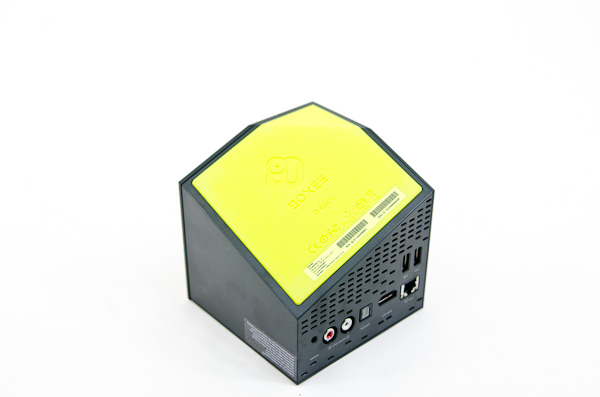








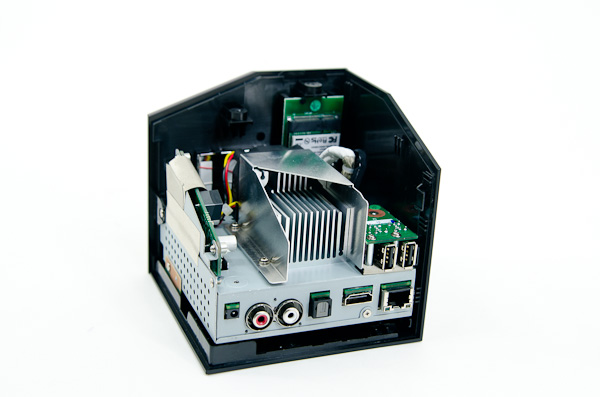
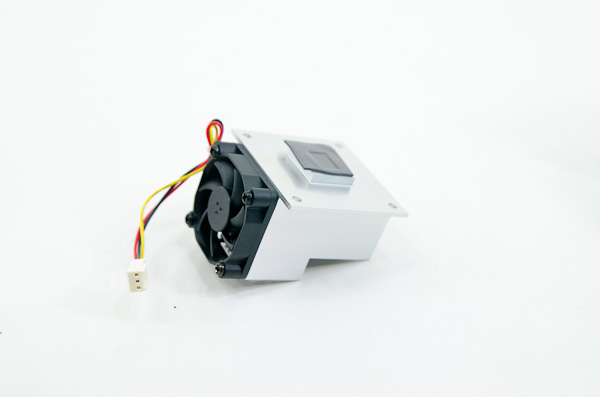
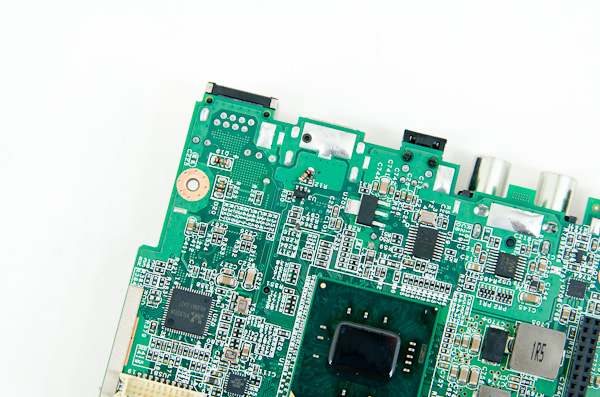









43 Comments
View All Comments
sprockkets - Tuesday, November 23, 2010 - link
Let's just say for instance, you don't use Windows and use Boxee since you can.$50 HDD
$30 for Ram
$42 for the cpu
$80 for a decent case with a fanless 65w psu or $50 case with $30 hq Seasonic psu
$140 for a motherboard. That's right, just a CPU won't cut it, it needs a decent chipset with hardware acceleration as well, and a Zotac 9300 itx board fills that need.
Figure $20 to ship and you get $362.
You still end up having to pay more, and you are left to assemble it. You get more, but $362 isn't $200, nor will it work OOTB.
Shadowmaster625 - Wednesday, November 24, 2010 - link
You dont need to be fanless. There are plenty of low cost cooling options available that are "silent enough" without having to pay a premium for fanless. However, I bet an underclocked, undervolted wolfdale celeron wouldnt even need a fan at all. Especially if you use something like a Q6600 stock heatsink. But even if it needed a fan it would only need to run at 500 rpm, which is pretty much inaudible.sprockkets - Wednesday, November 24, 2010 - link
That system isn't fanless, just the PSU. In either case, finding a good mini-itx case with a hq ps is next to impossible, at $50.Like you said, the fan even on a dual core 2.5 ghz processor is quite silent, but the psu one is noticeable. Still, to compare apples to apples as much as possible, I compared it with a hardware accel. chipset, and those cost more.
azcoyote - Tuesday, November 23, 2010 - link
Any chance you could test this with PlayOn.tv, particularly the HULU stream (no subscription required)???PlayOn.TV plus Netflix is how I got free of DirecTV.
Thanks!
schreinereiner - Tuesday, November 23, 2010 - link
I actually have a Boxee Box and have been using it in conjunction with PlayOn from day one and am very happy with it so far. Have not had bigger issues so far mainly using Hulu, Comedy Central, and Netflix (inlieu of a native app for the Boxee Box which has been announced to be ready in the next 4-5 weeks before the end of the year).AmdInside - Tuesday, November 23, 2010 - link
10 watts on standby? That's a deal breaker for me. For a device that I would leave connected all the time, that is too much standby power draw.JarredWalton - Tuesday, November 23, 2010 - link
For a person with "AMDInside" as their name, that's a little ironic isn't it? I mean, we're talking $10 per year at average power pricing to have it plugged in and running 24/7.gigahertz20 - Tuesday, November 23, 2010 - link
Well, so much for the Boxee Box hype, I think the next media streamer I get will be the new Popcorn Hour A-210. It's the same thing as the A-200 hardware wise I think, but the case is now aluminum and fanless, which were the main drawbacks for the A-200. I have owned a A-110 for over a year now and it has played back everything.I'd love to see Anandtech do a review of both the Popcorn Hour A-210 and the new Netgear NeoTV.
Also, the last page of the review has some spelling/grammar mistakes. Below:
"But parting iwth $199 for a product with bugs"
"You can’t build an similarly capable HTPC"
schreinereiner - Tuesday, November 23, 2010 - link
My approach right now due to the generous return window on Amazon (at least in the US) for pre-Christmas purchases is to give it until early January and re-evaluate.I went through the early Sigma players, returned a PopBox, am still fiddling with an Acer Revo Xbmc setup and have to say that with all its shortcomings the Boxee Box is the closest anyone in my eyes has gotten to marrying on- and offline content successfully while maintaining the simplicity of a set-top box. The first firmware update to address some bugs is planned for likely the end of this week. It's already being beta-tested.
spambonk - Tuesday, November 23, 2010 - link
" so if you want to truly save power you’ll have to shut the Boxee Box down completely."Do you chose the shutdown option, or pull the plug out of the socket?